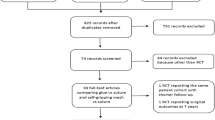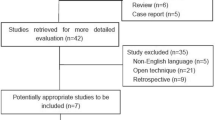Abstract
Introduction
Morbidity following open inguinal hernia repair is mainly related to chronic pain. ProGrip™ is a self-gripping mesh which aims to reduce rates of chronic pain. The aim of this study is to perform an update meta-analysis to consolidate the non-superiority hypothesis in terms of postoperative pain and recurrence and perform a trial sequential analysis.
Methods
Systematic review of randomised controlled trials performed according to PRISMA guidelines. Pooled odds ratios with 95% confidence intervals (CI) were calculated using the Mantel–Haenszel (M–H) method. The primary outcome measure was postoperative pain and secondary outcomes were recurrence, operative time, wound complications, length of stay, re-operation rate, and cost. Trial sequential analysis was performed.
Results
There were 14 studies included in the quantitative analysis with 3180 patients randomised to self-gripping mesh (1585) or standard mesh (1595). At all follow-up time points, there was no significant difference in the rates of chronic pain between the self-gripping and standard mesh (risk ratio, RR 1.10, 95% confidence interval, CI 0.83–1.46). There were no significant differences in recurrence rates (RR 1.13, CI 0.84–2.04). The mean operating time was significantly shorted in the ProGrip™ mesh group (MD − 7.32 min, CI − 10.21 to − 4.44). Trial sequential analysis suggests findings are conclusive.
Conclusion
This meta-analysis has confirmed no benefit of a ProGrip™ mesh when compared to a standard sutured mesh for open inguinal hernia repair in terms of chronic pain or recurrence. No further trials are required to address this clinical question.












Similar content being viewed by others
References
Simons MP, Aufenacker TJ, Berrevoet F, Bingener J, Bisgaard T, Bittner R, Bonjer HJ, Bury K, Campanelli G, Chen DC, Chowbey PK (2017) World guidelines for groin hernia management
Nordin P, Bartelmess P, Jansson C, Svensson C, Edlund G (2002) Randomized trial of Lichtenstein versus Shouldice hernia repair in general surgical practice. Br J Surg 89(1):45–49
Lange JFM, Kaufmann R, Wijsmuller AR, Pierie JPEN, Ploeg RJ, Chen DC, Amid PK (2015) An international consensus algorithm for management of chronic postoperative inguinal pain. Hernia 19(1):33–43
Amid PK (2004) Radiologic images of meshoma: a new phenomenon causing chronic pain after prosthetic repair of abdominal wall hernias. Arch Surg 139(12):1297–1298
Wijsmuller AR, Van Veen RN, Bosch JL, Lange JFM, Kleinrensink GJ, Jeekel J, Lange JF (2007) Nerve management during open hernia repair. Br J Surg 94(1):17–22
Amid PK (2004) Causes, prevention, and surgical treatment of postherniorrhaphy neuropathic inguinodynia: triple neurectomy with proximal end implantation. Hernia 8(4):343–349
Amid PK (2004) Lichtenstein tension-free hernioplasty: its inception, evolution, and principles. Hernia 8(1):1–7
Molegraaf M, Kaufmann R, Lange J (2018) Comparison of self-gripping mesh and sutured mesh in open inguinal hernia repair: a meta-analysis of long-term results. Surgery 163(2):351–360
Sajid MS, Farag S, Singh KK, Miles WF (2014) Systematic review and meta-analysis of published randomized controlled trials comparing the role of self-gripping mesh against suture mesh fixation in patients undergoing open inguinal hernia repair. Updates Surg 66(3):189–196
Verhagen T, Zwaans WAR, Loos MJA, Charbon JA, Scheltinga MRM, Roumen RMH (2016) Randomized clinical trial comparing self-gripping mesh with a standard polypropylene mesh for open inguinal hernia repair. Br J Surg 103(7):812–818
Sanders DL, Nienhuijs S, Ziprin P, Miserez M, Gingell-Littlejohn M, Smeds S (2014) Randomized clinical trial comparing self-gripping mesh with suture fixation of lightweight polypropylene mesh in open inguinal hernia repair. Br J Surg 101(11):1373–1382
Zhang C, Li F, Zhang H, Zhong W, Shi D, Zhao Y (2013) Self-gripping versus sutured mesh for inguinal hernia repair: a systematic review and meta-analysis of current literature. J Surg Res 185(2):653–660
Pandanaboyana S, Mittapalli D, Rao A, Prasad R, Ahmad N (2014) Meta-analysis of self-gripping mesh (Progrip) versus sutured mesh in open inguinal hernia repair. Surgeon 12(2):87–93
University of York, Centre for Reviews and Dissemination. PROSPERO; International Prospective Register of systematic reviews. https://www.crd.york.ac.uk/PROSPERO/
Liberati A, Altman DG, Tetzlaff J, Mulrow C, Gøtzsche PC, Ioannidis JP, Clarke M, Devereaux PJ, Kleijnen J, Moher D (2009) The PRISMA statement for reporting systematic reviews and meta-analyses of studies that evaluate health care interventions: explanation and elaboration. PLoS Med 6(7):e1000100
Higgins JPT, Deeks JJ (2011) Obtaining standard deviations from standard errors, confidence intervals, t values and p values for differences in means. In: Higgins JPT, Green S (eds) Cochrane handbook for systematic reviews of interventions. Version 5.1.0 [updated March 2011]. The Cochrane Collaboration. www.cochrane-handbook.org.
DeMets D, Lan KK (1994) Interim analysis: the alpha spending function approach. Stat Med 12:1341–1352
O'Brien PC, Fleming TR (1979) A multiple testing procedure for clinical trials. Biometrics 35:549–556
Higgins JP, Altman DG (2009) Assessing risk of bias in included studies. In: Higgins JP, Green S (eds) Cochrane handbook for systematic reviews of interventions. Wiley, West Sussex, pp 187–235
Zwaans WA, Verhagen T, Wouters L, Loos MJ, Roumen RM, Scheltinga MR (2018) Groin pain characteristics and recurrence rates: three-year results of a randomized controlled trial comparing self-gripping Progrip mesh and sutured polypropylene mesh for open inguinal hernia repair. Ann Surg 267(6):1028–1033
Jorgensen LN, Sommer T, Assaadzadeh S, Strand L, Dorfelt A, Hensler M, Rosenberg J, Danish Multicentre DANGRIP Study Group (2013) Randomized clinical trial of self-gripping mesh versus sutured mesh for Lichtenstein hernia repair. Br J Surg 100(4):474–481
Fernandez A, Pena Soria M, Jimenez-Valladolid D, Cabeza J, Perez Jimenez A, Florez Gamarra M, Estela L, del Pozo P, Garcia Galocha J, Romera Martinez J, Rojo Abecia M, Avellana R, Torres Garcia A (2017) Mesh fixation technique comparison in Lichtenstein hernioplasty, preliminary results of a prospective randomized study. Hernia 21(2):21–27
Suárez-Grau JM, Luque JB, Moreno JG, Menchero JG, Ferreras ID, Romero RM, Lupiañez ER, Jurado JG (2012) Postoperative pain and surgical time in Inguinal hernia repair with self-gripping mesh: experience in ambulatory surgery. Ambul Surg 18:18–20
Porrero JL, Castillo MJ, Pérez-Zapata A, Alonso MT, Cano-Valderrama O, Quirós E, Villar S, Ramos B, Sánchez-Cabezudo C, Bonachia O, Marcos A (2015) Randomised clinical trial: conventional Lichtenstein vs hernioplasty with self-adhesive mesh in bilateral inguinal hernia surgery. Hernia 19(5):765–770
Esteban MB, Pallarés MC, De Rojas EAS (2010) Use of adhesive mesh in hernioplasty compared to the conventional technique. Results of a randomised prospective study. Cirugía Española 88(4):253–258
Fan JKM, Yip J, Foo DCC, Lo OSH, Law WL (2017) Randomized trial comparing self gripping semi re-absorbable mesh (PROGRIP) with polypropylene mesh in open inguinal hernioplasty: the 6 years result. Hernia 21(1):9–16
Molegraaf MJ, Grotenhuis B, Torensma B, de Ridder V, Lange JF, Swank DJ (2017) The HIPPO Trial, a randomized double-blind trial comparing self-gripping Parietex Progrip mesh and sutured Parietex mesh in Lichtenstein hernioplasty: a long-term follow-up study. Ann Surg 266(6):939–945
Rönkä K, Vironen J, Kössi J, Hulmi T, Silvasti S, Hakala T, Ilves I, Song I, Hertsi M, Juvonen P, Paajanen H (2015) Randomized multicenter trial comparing glue fixation, self-gripping mesh, and suture fixation of mesh in Lichtenstein hernia repair (FinnMesh Study). Ann Surg 262(5):714–720
Nikkolo C, Vaasna T, Murruste M, Suumann J, Kirsimägi Ü, Seepter H, Tein A, Lepner U (2017) Three-year results of a randomized study comparing self-gripping mesh with sutured mesh in open inguinal hernia repair. J Surg Res 209:139–144
Nikkolo C, Vaasna T, Murruste M, Seepter H, Suumann J, Tein A, Kirsimägi Ü, Lepner U (2015) Single-center, single-blinded, randomized study of self-gripping versus sutured mesh in open inguinal hernia repair. J Surg Res 194(1):77–82
Kapischke M, Schulze H, Caliebe A (2010) Self-fixating mesh for the Lichtenstein procedure—a prestudy. Langenbeck's Arch Surg 395(4):317–322
Kingsnorth A, Gingell-Littlejohn M, Nienhuijs S, Schüle S, Appel P, Ziprin P, Eklund A, Miserez M, Smeds S (2012) Randomized controlled multicenter international clinical trial of self-gripping Parietex™ ProGrip™ polyester mesh versus lightweight polypropylene mesh in open inguinal hernia repair: interim results at 3 months. Hernia 16(3):287–294
Chatzimavroudis G, Papaziogas B, Koutelidakis I, Galanis I, Christopoulos P, Voloudkis N, Kotoreni G, Laskou S, Christofordis E (2014) Long-term follow-up of a prospective randomized study comparing polypropylene mesh fixed with sutures vs. self-fixating polypropylene mesh in inguinal hernia repair. Hernia 21(2):195–200
Porter ME (2010) What is value in health care? N Engl J Med 363(26):2477–2481
Matthews JH, Bhanderi S, Chapman SJ, Nepogodiev D, Pinkney T, Bhangu A (2016) Underreporting of secondary endpoints in randomized trials. Ann Surg 264(6):982–986
Bhangu A, Singh P, Pinkney T, Blazeby JM (2015) A detailed analysis of outcome reporting from randomised controlled trials and meta-analyses of inguinal hernia repair. Hernia 19(1):65–75
Burcharth J, Pommergaard HC, Bisgaard T, Rosenberg J (2015) Patient-related risk factors for recurrence after inguinal hernia repair: a systematic review and meta-analysis of observational studies. Surg Innov 22(3):303–317
Chatzimavroudis G, Papaziogas B, Koutelidakis I, Galanis I, Atmatzidis S, Christopoulos P, Doulias T, Atmatzidis K, Makris J (2014) Lichtenstein technique for inguinal hernia repair using polypropylene mesh fixed with sutures vs self-fixating polypropylene mesh: a prospective randomized comparative study. Hernia 18(2):93–198
Miserez M, Peeters E, Aufenacker T, Bouillot JL, Campanelli G, Conze J, Fortelny R, Heikkinen T, Jorgensen LN, Kukleta J, Morales-Conde S (2014) Update with level 1 studies of the European Hernia Society guidelines on the treatment of inguinal hernia in adult patients. Hernia 18(2):151–163
Esteban MB, Pallarés MC, de Rojas EAS, Vila MJ (2014) Prospective randomized trial of long-term results of inguinal hernia repair using autoadhesive mesh compared to classic Lichtenstein technique with sutures and polypropylene mesh. Cirugía Española 92(3):195–200
Pierides G, Scheinin T, Remes V, Hermunen K, Vironen J (2012) Randomized comparison of self-fixating and sutured mesh in open inguinal hernia repair. Br J Surg 99(5):630–636
Funding
There are no sources of funding for this research.
Author information
Authors and Affiliations
Corresponding author
Ethics declarations
Disclosures
Naomi L. Bullen, Shahin Hajibandeh, Shahab Hajibandeh, Neil J. Smart, Stavros A. Antoniou have no conflicts of interest or financial ties to disclose.
Additional information
Publisher's Note
Springer Nature remains neutral with regard to jurisdictional claims in published maps and institutional affiliations.
Electronic supplementary material
Below is the link to the electronic supplementary material.


Rights and permissions
About this article
Cite this article
Bullen, N.L., Hajibandeh, S., Hajibandeh, S. et al. Suture fixation versus self-gripping mesh for open inguinal hernia repair: a systematic review with meta-analysis and trial sequential analysis. Surg Endosc 35, 2480–2492 (2021). https://doi.org/10.1007/s00464-020-07658-6
Received:
Accepted:
Published:
Issue Date:
DOI: https://doi.org/10.1007/s00464-020-07658-6




